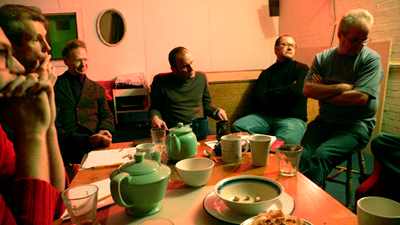Monday February 6th 2006.
Present:
Nicholas Berwin, arts+financial consultant; John Levack Drever, electroacoustic composer; Paul Gillieron, acoustic consultant; Alex Haw, architect; Garrick Jones, social psychologist; Kaffe Matthews, artist +M4B director; Mark Miodownik, materials physicist; David Muth, programmer, musician; Peter Smith, bio-resonance practitioner.
Kaffe presented and introduced Music for Bodies as a collaborative research project looking for input and collaboration from multi-disciplinary professionals. Sonic Bed was introduced as the interface which would first be researched and developed with new music being made for it as a result of the work of the Instrument Team, (musician/programmer David Muth and architect Alex Haw).
Central issues raised:
1. The bed is a passive space, where visitors lie down and receive. Could it be made active, ie. interactive? discussed: a) Could an instrument be made from a trampoline? b) Could the space within which the bed is installed be used through feedback systems to develop its interactivity? Cluster Flux and the work of Garnet Willis was cited, where the sounding board of a harpsichord exists as a live sound piece that is activated by presence and movement within the room for it to sound.
2. One intention is to undertake to create more sonic beds around the world using this one as the form from which the others could all be made. However, will this current form be developed , in which case, the range of worldwide beds could be developed too? If so, how ?
Possible development areas discussed:- a) The possibility of the bed playing 3D sound. This could be achieved by positioning speakers in the bed that pointed upwards so their output would be reflected off the ceiling, giving the effect of sound also playing down onto the lying bodies. Of course this could also be achieved by installing a speaker above the bed,(ambisonics)
b) The bed could be made more cosy, enveloping. Even with some kind of cover/lid, so that a visitor would need to crawl inside it. Its current style is maybe too minimal/hard? open?
c) Another kind of mattress/lying surface could be used. eg. a water or air mattress, another kind of foam, even a body shaped foam mattress, memory foam? or sculpted foam surface.
d) Create a suspended vibrating net mesh which would also reveal all the technology within.
Overall then it was concluded that the research could look at creating the ultimate bed by : –
1. Research materials of the mattress.
2. Research the actual effect of different frequencies on different parts of the body and map them.
3. Explore different means of holding the prone body within the sonic vibration field: mattress materials, suspension net.
3. The marketing of the bed. Apart from health and artistic selling points, the idea of the bed also being sold as a device to help develop listening was raised, with the idea that this could in itself be useful in aiding the learning of new languages. i.e. make a super quiet bed.
Here arose a discussion about ambisonics and the possibility of developing a noise cancellation system to create that.
4. One of the most valuable points raised during this inspiring first 3 hour session was acknowledging that this is a period of unknowing which is vital and valuable and rare and not something to be frightened of. Lets use it and see where it takes us.
Beyond the specifics, the Think Tank is also considering the BIGGER PICTURE. Considering the overall intentions of Music for Bodies, is this work taking us where it needs to?


